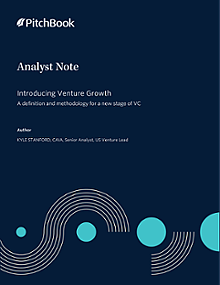
Q4 2022
PitchBook Analyst Note: Introducing Venture Growth
November 30, 2022
The venture capital market has changed tremendously since PitchBook developed a methodology for segmenting the asset class by stages. The biggest shift has been in the late stage, which up until now we defined as all companies that are more than five years old or have raised a Series C round.
But as VC-backed companies stay private for longer and collect more capital along the way, we have found that the smaller startups in our late-stage dataset have become considerably different from the larger ones.
To better address the variation and trends in late-stage venture, we decided to create a new category that we are calling the “venture growth stage.” The new segment will be defined as any company that raised a Series E or a later round or financings involving companies that are at least seven years old and have raised at least six VC rounds. In our latest analyst note, PitchBook analyst Kyle Stanford details how the new stage has changed over the last decade and explains why its risk profile differs from angel, seed, early, and late stages.
Table of contents
| Key takeaways | 1 |
| Introduction | 2 |
| Why is a new stage needed? | 3 |
| How did we develop the methodology? | 6 |
| Venture growth dataset | 7 |
| Moving forward | 11 |